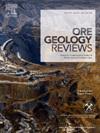Genesis of the Longfengchang polymetallic sulfide deposit in the southwest Fujian depression, southeast China, with a comparative study of the “Makeng-Type” iron deposit
IF 3.2
2区 地球科学
Q1 GEOLOGY
引用次数: 0
Abstract
The Southwest Fujian Depression Belt is a prominent metallogenic zone for skarn-type iron polymetallic deposits in China, with the Longfengchang (LFC) sulfur polymetallic deposit representing a medium-scale, sulfide-dominated deposit in this region. This study conducted a detailed analysis of the LFC deposit, focusing on its mineralogy, mineral composition, and in-situ sulfur isotopes, alongside a comparative study with the “Makeng-type” deposit. The study aims to elucidate the genesis of the LFC deposit, its relationship with the “Makeng-type” deposit, and the factors underlying differences in dominant economic minerals and resource scale. The LFC deposit is hosted within the skarn above the fault contact zone between the Lindi Formation sandstone and the Chuanshan–Qixia Formation carbonate, with mineralization stages classified as skarn-magnetite, quartz-sulfide, and carbonate. LFC garnets are primarily composed of CaO, TFeO, and SiO2, with minor Al2O3 and trace amounts of MgO and MnO, classifying them as distal exoskarn andradite. The presence of Mn3+ substituting for Fe3+ in garnet suggests that the ore-forming fluid during the garnet skarn stage was likely oxidizing and weakly acidic. LFC pyrites exhibit Co/Ni ratios primarily ranging from 1 to 10, decreasing from Py1 to Py3. In-situ sulfur isotope δ34S values range from −1.48 to 3.51 ‰, centering around 0 ‰, and increase from Py1 to Py3, suggesting a magmatic-hydrothermal origin and a cooling metallogenic process. Thus, the LFC deposit is classified as a magmatic-hydrothermal skarn-type deposit, consistent with the genesis of “Makeng-type” deposits. The absence of the Jinshe Formation, and mantle-derived magma contribution, and less developed “Si-Ca” interface may explain the smaller scale and different mineralization type in the LFC deposit compared to the “Makeng-type” deposit. The key prospecting area for large iron-sulfur polymetallic deposits in the Southwest Fujian Depression Belt should feature a nappe structural window, well-preserved Jinshe Formation, developed “Si-Ca” interface, Yanshanian high-K calc-alkaline to shoshonitic intrusions, and coeval mantle-derived magma.

中国东南部闽西南坳陷龙凤场多金属硫化物矿床成因及 "马坑型 "铁矿床比较研究
闽西南凹陷带是中国矽卡岩型铁多金属矿床的重要成矿带,其中龙凤场硫多金属矿床是该地区以硫化物为主的中型矿床。本研究对龙凤场硫多金属矿床进行了详细分析,重点关注其矿物学、矿物组成和原位硫同位素,并与 "马坑型 "矿床进行了对比研究。该研究旨在阐明 LFC 矿床的成因、它与 "Makeng 型 "矿床的关系,以及造成主要经济矿物和资源规模差异的因素。LFC 矿床赋存于林地层砂岩与穿山-栖霞层碳酸盐岩断层接触带上方的矽卡岩中,成矿阶段分为矽卡岩-磁铁矿、石英-硫化物和碳酸盐岩。LFC 石榴石的主要成分是 CaO、TFeO 和 SiO2,还有少量 Al2O3 以及微量的 MgO 和 MnO,因此被归类为远期外矽卡岩和斜长石。石榴石中 Mn3+ 替代 Fe3+ 的存在表明,石榴石矽卡岩阶段的成矿流体很可能是氧化性和弱酸性的。LFC 黄铁矿的钴/镍比值主要在 1 到 10 之间,从 Py1 到 Py3 依次降低。原位硫同位素δ34S值范围在-1.48到3.51‰之间,以0‰为中心,从Py1到Py3依次增大,这表明了岩浆-热液成因和冷却成矿过程。因此,LFC矿床属于岩浆-热液矽卡岩型矿床,与 "马坑型 "矿床的成因一致。与 "Makeng 型 "矿床相比,LFC 矿床规模较小,成矿类型不同,其原因可能是没有金社地层和地幔岩浆的贡献,以及 "Si-Ca "界面不发达。闽西南凹陷带大型铁硫多金属矿床的重点找矿区域应具有岩浆构造窗口、保存完好的金畲地层、发育的 "Si-Ca "界面、燕山期高K钙碱性至闪长岩侵入体以及共生的地幔源岩浆。
本文章由计算机程序翻译,如有差异,请以英文原文为准。
求助全文
约1分钟内获得全文
求助全文
来源期刊

Ore Geology Reviews
地学-地质学
CiteScore
6.50
自引率
27.30%
发文量
546
审稿时长
22.9 weeks
期刊介绍:
Ore Geology Reviews aims to familiarize all earth scientists with recent advances in a number of interconnected disciplines related to the study of, and search for, ore deposits. The reviews range from brief to longer contributions, but the journal preferentially publishes manuscripts that fill the niche between the commonly shorter journal articles and the comprehensive book coverages, and thus has a special appeal to many authors and readers.
 求助内容:
求助内容: 应助结果提醒方式:
应助结果提醒方式:


